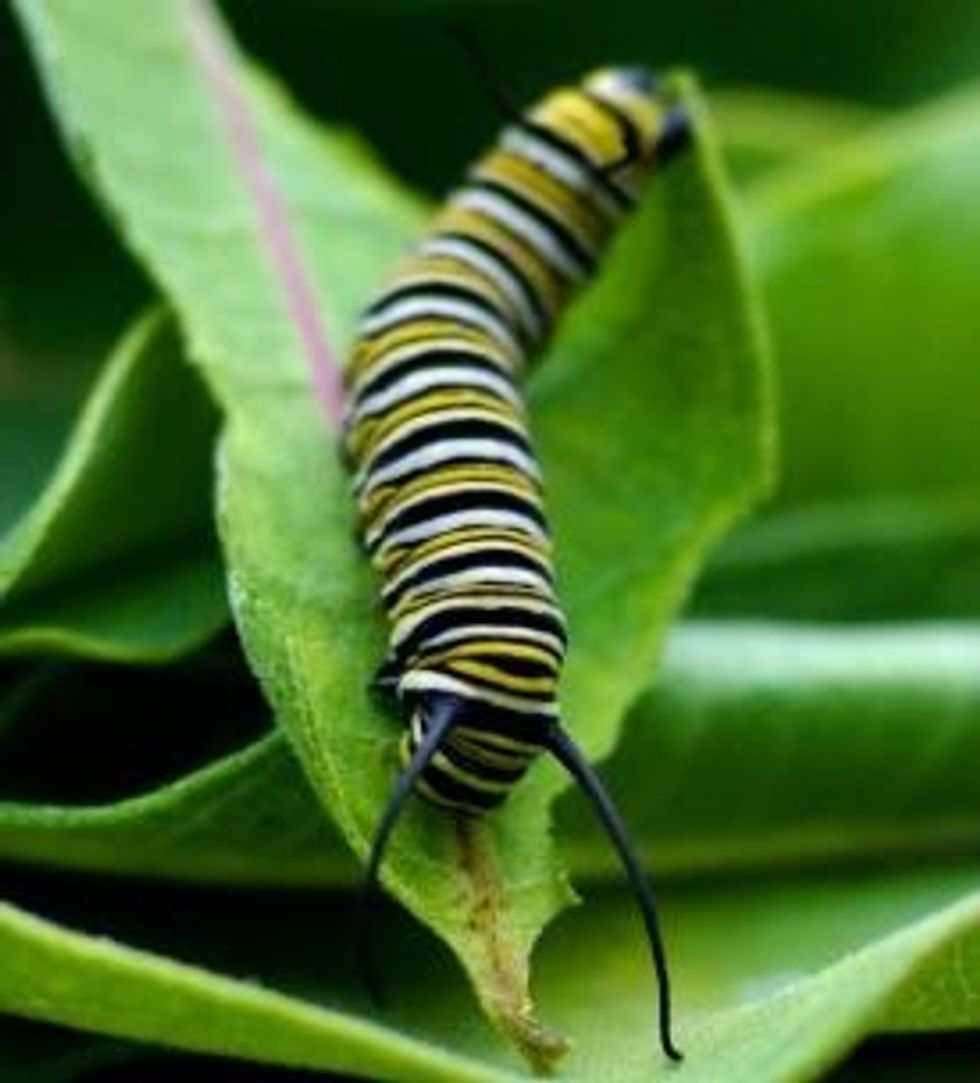Genetically Modified Crops Fueling Decline of Monarch Butterflies: Report
New study links loss of milkweed habitat as a result of herbicide resistant crops to monarchs' falling numbers
The monarch butterflies' numbers have been plummeting in recent years, and a new study has pointed to the likely main culprit: loss of its summer habitat as a result of genetically modified crops.
The findings from researchers with the University of Guelph were published Wednesday in the Journal of Animal Ecology.
A report issued earlier this year from the World Wildlife Fund and Mexico's National Commission for Protected Areas pointed to three main factors threatening the pollinators: deforestation and forest degradation in monarch reserves that serve as their winter habitat in Mexico, habitat loss due to land use changes and the loss of its larval food plant--milkweed--as a result of the widespread use of the herbicide glyphosate, and weather extremes.
The new study, however, puts the main cause of the crisis squarely on its summer habitat loss in the United States.
The researchers' projection model showed that disturbances in their breeding grounds affected the butterflies' number to a greater degree than disturbances to their wintering grounds. Those breeding grounds need to have milkweed, the only host plant for the monarch caterpillars.

"Our work provides the first evidence that monarch butterfly numbers in eastern North America are most sensitive to changes in the availability of milkweed on breeding grounds, particularly in the Corn Belt region of the United States," stated Ryan Norris, a professor in Guelph's Department of Integrative Biology and study co-author.
Efforts by the Mexican government to conserve winter monarch habitat have "no doubt gone a long way towards conserving monarchs that breed throughout eastern North America," stated lead author and current University of Guelph post-doctoral researcher Tyler Flockhart. "However, our results provide evidence that there is now another imminent threat."
Speaking with CBC News, Norris said that "likely the biggest cause of loss of milkweed is the adoption of genetically modified crops."
The study also predicts further declines in the population of 14 percent, and a 5 percent chance the species goes nearly extinct within a centruy.
So how do we stop the population free-fall?
"Reducing the negative effects of milkweed loss in the breeding grounds should be the top conservation priority to slow or halt future population declines of the monarch in North America," Flockhart stated.
To do that, Norris added, "Planting milkweed in the south and central United States would provide the largest immediate benefit."
Encouraging the planting of milkweed is something Ward's Monarch Watch has been encouraging for years, and in a monarch "recovery plan" he states:
The monarch migration can be saved if there is commitment to the two propositions outlined in the premise to 1) offset annual losses of habitat by planting milkweeds and nectar plants in areas from which they have been extirpated and 2) develop the capacity to plant milkweeds over large landscapes. Both projects require the development of greater capacity to restore milkweeds than exists at present.
But that capacity, though costly, could be implemented within a few years, he adds.
In addition to the efforts individuals can make in restoring the habitat, the study's findings point to a need for a fundamental shift away from current, herbicide-reliant agricultural practices and ethanol mandates that have incentivized corn monocultures and destroyed milkweed.
_______________________________
An Urgent Message From Our Co-Founder
Dear Common Dreams reader, The U.S. is on a fast track to authoritarianism like nothing I've ever seen. Meanwhile, corporate news outlets are utterly capitulating to Trump, twisting their coverage to avoid drawing his ire while lining up to stuff cash in his pockets. That's why I believe that Common Dreams is doing the best and most consequential reporting that we've ever done. Our small but mighty team is a progressive reporting powerhouse, covering the news every day that the corporate media never will. Our mission has always been simple: To inform. To inspire. And to ignite change for the common good. Now here's the key piece that I want all our readers to understand: None of this would be possible without your financial support. That's not just some fundraising cliche. It's the absolute and literal truth. We don't accept corporate advertising and never will. We don't have a paywall because we don't think people should be blocked from critical news based on their ability to pay. Everything we do is funded by the donations of readers like you. Will you donate now to help power the nonprofit, independent reporting of Common Dreams? Thank you for being a vital member of our community. Together, we can keep independent journalism alive when it’s needed most. - Craig Brown, Co-founder |
The monarch butterflies' numbers have been plummeting in recent years, and a new study has pointed to the likely main culprit: loss of its summer habitat as a result of genetically modified crops.
The findings from researchers with the University of Guelph were published Wednesday in the Journal of Animal Ecology.
A report issued earlier this year from the World Wildlife Fund and Mexico's National Commission for Protected Areas pointed to three main factors threatening the pollinators: deforestation and forest degradation in monarch reserves that serve as their winter habitat in Mexico, habitat loss due to land use changes and the loss of its larval food plant--milkweed--as a result of the widespread use of the herbicide glyphosate, and weather extremes.
The new study, however, puts the main cause of the crisis squarely on its summer habitat loss in the United States.
The researchers' projection model showed that disturbances in their breeding grounds affected the butterflies' number to a greater degree than disturbances to their wintering grounds. Those breeding grounds need to have milkweed, the only host plant for the monarch caterpillars.

"Our work provides the first evidence that monarch butterfly numbers in eastern North America are most sensitive to changes in the availability of milkweed on breeding grounds, particularly in the Corn Belt region of the United States," stated Ryan Norris, a professor in Guelph's Department of Integrative Biology and study co-author.
Efforts by the Mexican government to conserve winter monarch habitat have "no doubt gone a long way towards conserving monarchs that breed throughout eastern North America," stated lead author and current University of Guelph post-doctoral researcher Tyler Flockhart. "However, our results provide evidence that there is now another imminent threat."
Speaking with CBC News, Norris said that "likely the biggest cause of loss of milkweed is the adoption of genetically modified crops."
The study also predicts further declines in the population of 14 percent, and a 5 percent chance the species goes nearly extinct within a centruy.
So how do we stop the population free-fall?
"Reducing the negative effects of milkweed loss in the breeding grounds should be the top conservation priority to slow or halt future population declines of the monarch in North America," Flockhart stated.
To do that, Norris added, "Planting milkweed in the south and central United States would provide the largest immediate benefit."
Encouraging the planting of milkweed is something Ward's Monarch Watch has been encouraging for years, and in a monarch "recovery plan" he states:
The monarch migration can be saved if there is commitment to the two propositions outlined in the premise to 1) offset annual losses of habitat by planting milkweeds and nectar plants in areas from which they have been extirpated and 2) develop the capacity to plant milkweeds over large landscapes. Both projects require the development of greater capacity to restore milkweeds than exists at present.
But that capacity, though costly, could be implemented within a few years, he adds.
In addition to the efforts individuals can make in restoring the habitat, the study's findings point to a need for a fundamental shift away from current, herbicide-reliant agricultural practices and ethanol mandates that have incentivized corn monocultures and destroyed milkweed.
_______________________________
The monarch butterflies' numbers have been plummeting in recent years, and a new study has pointed to the likely main culprit: loss of its summer habitat as a result of genetically modified crops.
The findings from researchers with the University of Guelph were published Wednesday in the Journal of Animal Ecology.
A report issued earlier this year from the World Wildlife Fund and Mexico's National Commission for Protected Areas pointed to three main factors threatening the pollinators: deforestation and forest degradation in monarch reserves that serve as their winter habitat in Mexico, habitat loss due to land use changes and the loss of its larval food plant--milkweed--as a result of the widespread use of the herbicide glyphosate, and weather extremes.
The new study, however, puts the main cause of the crisis squarely on its summer habitat loss in the United States.
The researchers' projection model showed that disturbances in their breeding grounds affected the butterflies' number to a greater degree than disturbances to their wintering grounds. Those breeding grounds need to have milkweed, the only host plant for the monarch caterpillars.

"Our work provides the first evidence that monarch butterfly numbers in eastern North America are most sensitive to changes in the availability of milkweed on breeding grounds, particularly in the Corn Belt region of the United States," stated Ryan Norris, a professor in Guelph's Department of Integrative Biology and study co-author.
Efforts by the Mexican government to conserve winter monarch habitat have "no doubt gone a long way towards conserving monarchs that breed throughout eastern North America," stated lead author and current University of Guelph post-doctoral researcher Tyler Flockhart. "However, our results provide evidence that there is now another imminent threat."
Speaking with CBC News, Norris said that "likely the biggest cause of loss of milkweed is the adoption of genetically modified crops."
The study also predicts further declines in the population of 14 percent, and a 5 percent chance the species goes nearly extinct within a centruy.
So how do we stop the population free-fall?
"Reducing the negative effects of milkweed loss in the breeding grounds should be the top conservation priority to slow or halt future population declines of the monarch in North America," Flockhart stated.
To do that, Norris added, "Planting milkweed in the south and central United States would provide the largest immediate benefit."
Encouraging the planting of milkweed is something Ward's Monarch Watch has been encouraging for years, and in a monarch "recovery plan" he states:
The monarch migration can be saved if there is commitment to the two propositions outlined in the premise to 1) offset annual losses of habitat by planting milkweeds and nectar plants in areas from which they have been extirpated and 2) develop the capacity to plant milkweeds over large landscapes. Both projects require the development of greater capacity to restore milkweeds than exists at present.
But that capacity, though costly, could be implemented within a few years, he adds.
In addition to the efforts individuals can make in restoring the habitat, the study's findings point to a need for a fundamental shift away from current, herbicide-reliant agricultural practices and ethanol mandates that have incentivized corn monocultures and destroyed milkweed.
_______________________________

